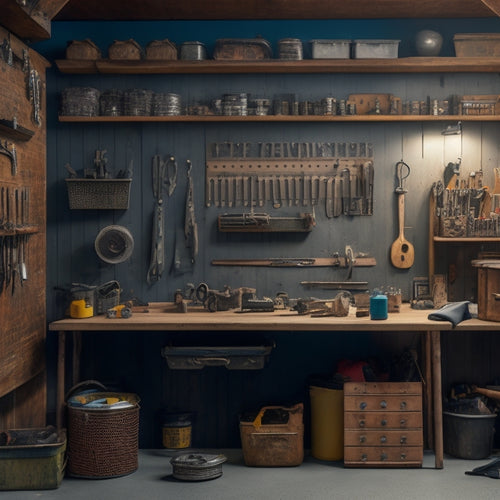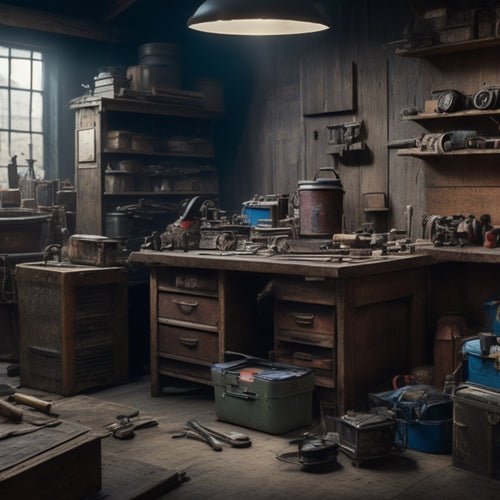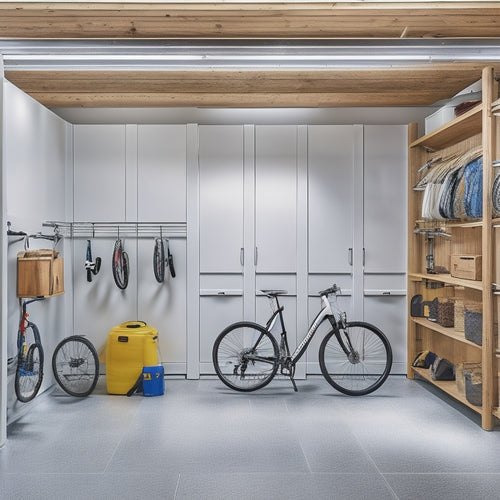
Top Storage Hacks for Organizing Boxes on Shelves
Share
To maximize your storage shelves, start by implementing clear labeling and signage strategies, using bright colors and consistent labels to quickly identify contents. Next, maximize vertical space by adjusting shelf heights, stacking heavier boxes at the bottom, and leaving room for easy retrieval. Consider a color-coded system to visually categorize your boxes, and use shelf dividers or bins to keep similar items together. By optimizing box size and shape, and placing frequently used boxes in accessible locations, you'll be well on your way to a streamlined storage system - and there's even more you can do to take your organization to the next level.
Key Takeaways
- Implement a consistent labeling system with clear and concise labels on box sides or tops for easy reading and quick identification.
- Maximize vertical shelf space by adjusting shelf height, stacking heavier boxes at the bottom, and leaving space between boxes for easy retrieval.
- Employ a color-coded system for quick content identification, using calming colors for specific categories and easily distinguishable colors.
- Optimize box size and shape by measuring dimensions, favoring rectangular boxes, and prioritizing reinforced edges for durability and stability.
- Place boxes in accessible locations, alternating orientation, and maintaining clearance between boxes, with labels on multiple sides for improved visibility.
Labeling and Signage Strategies
When it comes to organizing boxes, one of the most critical steps is labeling and signage. You'll want to make certain you're using clear and concise labeling materials, such as stickers, labels, or even color-coding, to identify what's inside each box. This will save you time and energy when searching for specific items.
Proper signage placement is also essential. Place labels on the sides or tops of boxes, depending on how they're stacked, to guarantee you can easily read the labels. Consider using a consistent labeling system throughout your storage area to maintain organization and coherence.
Additionally, consider the visibility of your signage. Use bright colors or bold fonts to make labels stand out, especially in dimly lit storage areas. This will help you quickly identify what you need, reducing the risk of accidents or injuries caused by rummaging through boxes.
Maximizing Vertical Shelf Space
Now that you've got your boxes labeled and signed, it's time to think about how to fit them all into your storage space. To maximize vertical shelf space, start by adjusting the shelf height to accommodate boxes of different sizes. This will help you make the most of your available space and prevent wasted areas.
When stacking boxes, use techniques that prioritize stability and safety. Place heavier boxes at the bottom and lighter ones on top to prevent them from toppling over. You can also alternate the direction of boxes to create a more stable stack.
Make sure to leave enough space between each box for easy retrieval and to prevent damage.
Additionally, consider using shelf dividers or bins to separate and categorize your boxes. This will help maintain organization and make it easier to find what you need.
Color-Coded Box Organization
By categorizing your boxes using a color-coded system, you'll be able to quickly identify the contents of each box without having to read the labels. This visual approach takes advantage of color psychology, which suggests that different hues can evoke distinct emotional responses and improve memory recall.
For instance, you can use calming blue for storage boxes containing winter clothing or soothing green for boxes holding gardening tools.
To take it a step further, consider incorporating seasonal themes into your color-coding system. Use lively oranges and yellows for summer storage boxes, while pastel shades can signify spring. This won't only make your storage area more visually appealing but also help you stay organized throughout the year.
When selecting colors, verify they're easily distinguishable, especially if you have limited lighting in your storage area. Avoid using colors that are too similar, as this can lead to confusion.
Shelf Divider Hacks
Since you've got your boxes color-coded, it's time to tackle the actual storage space. Now, it's essential to maximize your shelf's capacity while keeping everything organized and easily accessible. This is where shelf divider hacks come in.
You can create your own DIY shelf dividers using materials like plywood, MDF, or even cardboard. Measure your shelf and cut the dividers to fit snugly between the boxes. This will prevent them from toppling over and create a clean, structured look.
For added flexibility, consider investing in an adjustable shelf system. These systems allow you to customize the shelf's layout as your storage needs change.
When designing your shelf dividers, remember to leave enough space between each box for easy retrieval. A general rule of thumb is to leave about 1-2 inches of clearance. This will guarantee you can safely remove and replace boxes without straining or damaging them.
Box Size and Shape Optimization
With your shelf dividers in place, it's time to turn your attention to the boxes themselves. Optimizing box size and shape is vital for efficient storage and safety. Start by taking stock of your box dimensions. Measure the length, width, and height of each box to determine the best way to stack them.
Consider the shape strategies that will allow you to fit the most boxes on your shelves while maintaining stability. For example, rectangular boxes with flat tops and bottoms are ideal for stacking, while boxes with tapered or curved sides may be better suited for standing upright.
When selecting boxes, prioritize those with reinforced edges and sturdy construction to prevent collapse or damage. Confirm the boxes aren't too heavy for the shelf or your lifting capacity, and avoid overpacking to prevent contents from shifting during storage.
Accessible Box Placement Tips
You've optimized your box size and shape, now it's time to focus on accessible box placement. This guarantees you can easily retrieve and store boxes without straining or risking accidents. When placing boxes on shelves, consider the following accessible box placement tips:
| Stacking Techniques | Clearance Considerations | Additional Tips |
|---|---|---|
| Alternate box orientation to increase stability | Leave 1-2 inches between boxes for easy removal | Label boxes on multiple sides for visibility |
| Place heavier boxes at the bottom | Confirm enough clearance for your hands to fit between boxes | Store frequently used boxes in easy-to-reach locations |
| Avoid stacking boxes too high to prevent toppling | Keep shelves at a comfortable height to avoid straining | Consider using shelf dividers to separate and organize boxes |
Frequently Asked Questions
How Often Should I Clean and Dust My Storage Shelves?
You should establish a regular cleaning schedule to maintain your storage shelves' organization and safety. Aim to dust every 2-3 weeks and deep clean every 2-3 months using gentle dusting techniques to prevent damage and allergen buildup.
Can I Use Storage Bins on Shelves With Uneven Surfaces?
Are you tired of dealing with wonky shelves? When using storage bins on shelves with uneven surfaces, you'll want to guarantee shelf stability by distributing box weight evenly, securing bins with straps or Velcro, and checking the shelf's capacity to prevent collapse.
Are Clear Storage Bins Better Than Opaque Ones?
When choosing storage bins, you'll find clear bins offer benefits like easy content visibility and reduced rummaging, while opaque bins have drawbacks like hidden contents and pest attraction, making clear bins a safer, more convenient choice for you.
Can I Store Heavy Items on Top Shelves?
You're building a proverbial house of cards when you store heavy items on top shelves, risking a catastrophic collapse. Guarantee weight distribution is even and shelf stability is solid to avoid a disaster, prioritizing safety over storage convenience.
How Do I Prevent Moisture Buildup in Stored Boxes?
You prevent moisture buildup in stored boxes by using moisture absorbers or silica gel packets inside them, and ensuring climate control in your storage area to maintain a consistent, dry temperature and humidity level.
Conclusion
You've finally tamed the storage beast! With these top storage hacks, your shelves are now a well-oiled machine, humming with efficiency. Think of your organized boxes as a orchestra, each one playing its part in perfect harmony. By implementing these strategies, you've created a system that's both functional and visually appealing. Now, go ahead and conduct your newly organized space with confidence!
Related Posts
-

Design Considerations for a Custom Pegboard
When designing a custom pegboard, you'll want to start by evaluating your storage needs, considering factors like too...
-

10 Best Tool Boxes for Every Budget and Job
You're looking for a tool box that fits your budget and job requirements. Whether you're a DIY enthusiast, electricia...
-

Modular Garage Organizers for Clutter-Free Spaces
You're likely wasting precious space in your garage due to inefficient storage and poor organization, but modular gar...


